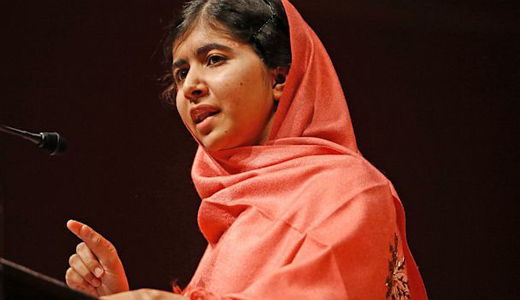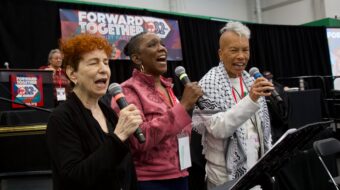
Malala Yousafzai, the 17-year-old Pakistani female education activist, shot and wounded but never silenced by the Taliban, became the youngest ever Nobel Peace Prize recipient last week.
Few women have ever won a Nobel Prize. Of the 867 awards distributed since 1901, just 46 have gone to women.
I was researching and writing the story of another female Nobel laureate from exactly 50 years ago when I read of Malala’s great news in the Morning Star.
In the autumn of 1964 Dorothy Crowfoot Hodgkin, a British chemist, became one of only four women who had ever won the Nobel prize for chemistry. Her prize was awarded for her pioneering work in protein crystallography.
The prize rewarded her more than 30 years of pioneering biochemical research that helped unravel the structures of proteins, including insulin and, among many other things, advanced the control of diabetes.
Dorothy Hodgkin was born Dorothy Mary Crowfoot in 1910.
She studied chemistry at Somerville College, Oxford, but moved to Cambridge University in 1932 to work on the development of X-ray crystallography with famous communist scientist J D Bernal. The couple had a close personal and political relationship.
Over the next four years Hodgkin and Bernal produced a dozen joint crystallographic papers. They also shared a Marxist view of the world. The two were part of what at the time was often known as Red Science.
Novelist and chemist C P Snow told communist historian Eric Hobsbawm that if they took a poll of a couple of hundred of the brightest young British scientists in the mid 1930s, they would have found around 15 Communist Party members, a good 50 more on the left and a hundred more proud of their leftist views.
In 1939 Bernal wrote his book The Social Function of Science. The work focuses on the way resources were allocated to various parts of science and technology.
At the heart of Bernal’s book -indeed his whole political thinking, and Hodgkin’s too – is a call to organise this great human power of science to serve the many, not the few.
In 1937, Dorothy married Thomas Lionel Hodgkin although her close relationship with Bernal would continue on and off for many years.
Her published letters show that neither she, nor her husband, nor Bernal had much time for conventional relationships.
Her new husband would become an Oxford lecturer, a member of the Communist Party and an advisor to Kwame Nkrumah, who took the Gold Coast, later Ghana, to independence from British rule.
Hodgkin and her husband would spend much time with Nkrumah, often described as the Lenin of Africa, in Ghana.
In the 1950s her and her husband’s communist politics would lead to her being banned from entering the US. This severely limited international research with US scientists. She was allowed just a few transatlantic visits by special permission from the CIA.
Around this time she and her old friend and mentor J D Bernal had key roles in the World Peace Council. This too brought them to the attention of the secret services on both sides of the Atlantic.
The pair worked together when the British Peace Committee attempted to host a world peace congress in Sheffield. British government obstructions caused a number of delegates to be stranded in London.
One was Pablo Picasso. At a gathering the artist drew a large dove of peace on Bernal’s sitting room wall. Today the drawing can be seen at London’s Wellcome Collection.
In April 1953 Hodgkin travelled from Oxford to Cambridge to see the model of the double helix structure of DNA.
Credit for the model and another Nobel Prize went to Francis Crick and James Watson, but much of the research had been carried out by another female chemist, and a close colleague of Hodgkin, Rosalind Franklin.
The two had discussed Franklin’s early X-ray photographs of the double helix a decade before Crick and Watson got their DNA Nobel prize. Franklin has never been given the credit she deserves for her work on DNA. Many think she should have been a third Nobel nomination along with Crick and Watson.
Hodgkin published as Dorothy Crowfoot until 1949, when she was persuaded to use her married name.
Hodgkin was always just as concerned about political and world issues as her scientific research. She was president of the Pugwash Conferences on Science and World Affairs from 1976 to 1988.
Pugwash is an international organisation that brings together scientists, scholars and public figures to work toward reducing the danger of armed conflict and to seek solutions to global security threats.
It was founded in Pugwash, Nova Scotia, in 1957 by Joseph Rotblat and Bertrand Russell. Rotblat and the Pugwash Conference jointly won the Nobel Peace Prize in 1995 for their efforts on nuclear disarmament.
Sadly Hodgkin’s reputation took a knock when she was swept into a scientific fraud involving Elena Ceausescu, the wife of the president of communist Romania.
Hodgkin wrote the foreword to the English edition of a scientific paper supposedly written by Ceausescu. Hodgkin quoted Ceausescu’s “outstanding achievements” and “impressive” career.
We now know that Ceausescu never finished secondary school, never attended university, that her scientific credentials and work were a complete fraud.
All the research published under her name throughout her life was written by a team of uncredited scientists. The incident cast a dark shadow over Hodgkin’s reputation as well as on science from the communist world.
As well as her Nobel Prize Hodgkin received many other honours.
Even the US forgave her communist politics. In 1958, she was elected a foreign honorary member of the American Academy of Arts and Sciences.
She was only the second woman to receive the Order of Merit in 1965 – the first was Florence Nightingale. Hodgkin was awarded the Soviet Union’s Lenin Peace Prize in 1987. She died in 1994.
Hodgkin had some interesting, if unexpected, admirers. In the 1940s, one of her chemistry students was Margaret Roberts, who would become Prime Minister Maggie Thatcher.
Thatcher hung a portrait of Hodgkin in 10 Downing Street – probably the only communist portrait ever to grace those walls.
Malala Yousafzai has shown just how impressive a woman needs to be to win a Nobel Prize.
Fifty years ago Dorothy Hodgkin did exactly the same and she remains the only British woman to have ever won one of the science Nobel Prizes.
Let’s salute these two women, half a century apart but who both demonstrate that, as a man called Mao Zedong once said, “women really do hold up half the sky” whatever the Nobel Prize judging panel may usually think.
This article was reposted from Morning Star.
Photo: AP












Comments